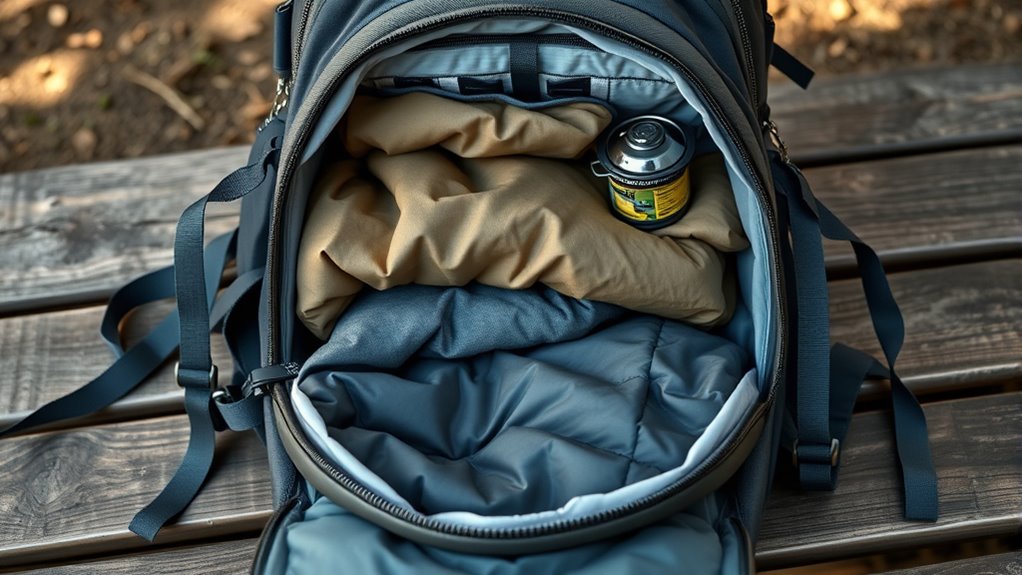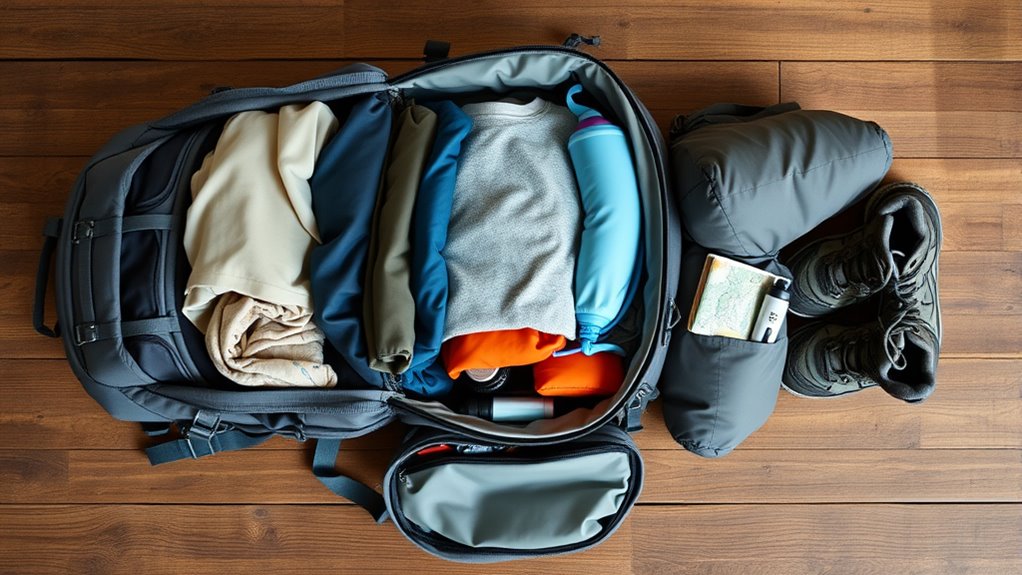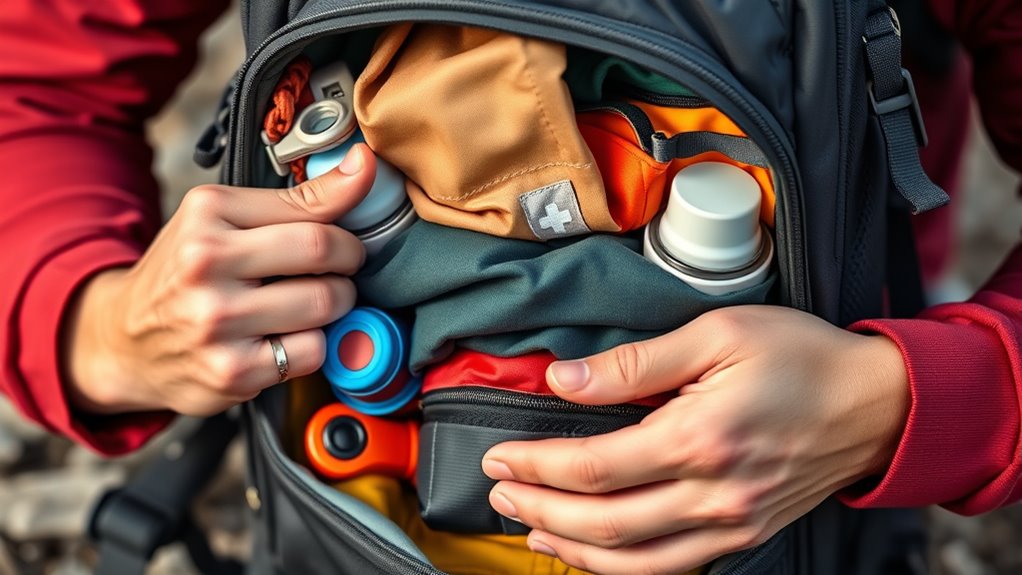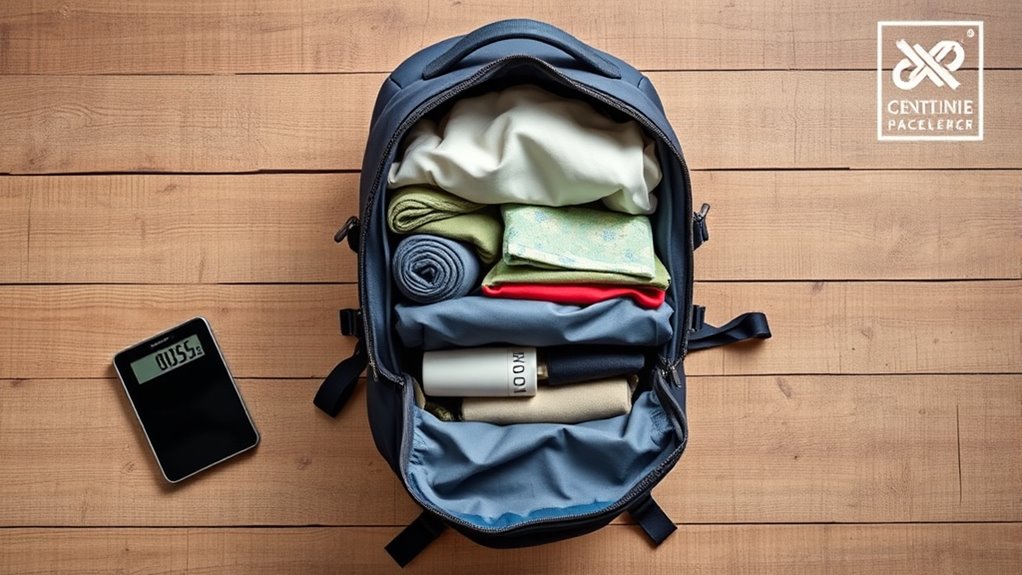To pack your backpack effectively, focus on proper weight distribution: keep heavier items close to your back and centered over your hips for stability and comfort. Organize gear using packing cubes, placing essentials within easy reach and lighter items on top. Balance your load by adjusting straps to prevent shifting and reduce fatigue. Prioritize lightweight, multi-purpose gear to avoid overpacking. Mastering these techniques guarantees a safer, more comfortable hike—continue to learn more tips and tricks.
Key Takeaways
- Place heavy items close to your back and centered over hips to maintain balance and reduce fatigue during hikes.
- Organize gear using packing cubes, with weightier items near the spine and lighter items on top for easier access.
- Prioritize essential, lightweight gear such as water, navigation tools, and basic camping supplies to prevent overpacking.
- Adjust straps regularly to secure and balance the load, ensuring comfort and stability throughout the trek.
- Avoid overpacking by focusing on multi-purpose items and compressing clothing to keep the pack manageable and balanced.
Understanding the Importance of Proper Weight Distribution

Proper weight distribution is essential to keep your backpack comfortable and balanced during your hike or trip. When you focus on correct weight distribution, you improve backpack ergonomics, reducing strain on your back and shoulders. Properly distributing weight means placing heavier items close to your back, centered over your hips, and balancing loads on both sides. This prevents uneven pressure that can cause discomfort or injury. Understanding how to manage weight distribution helps you maintain good posture and move efficiently. Keep in mind that an ergonomically packed backpack minimizes fatigue and enhances stability, especially on uneven terrain. Additionally, utilizing vertical storage solutions can help optimize weight placement and organization. By paying attention to how you distribute your gear, you ensure a more comfortable, safer, and enjoyable outdoor experience.
Packing Strategies for a Balanced Backpack

To maintain a balanced backpack, start by organizing your gear with weight distribution in mind. Think about clothing choices and weather preparedness to prevent overpacking or uneven loads. Place heavier items, like your main clothing layers, near your spine and close to your center of gravity. Lighter items, such as snacks or small accessories, go toward the top or outer compartments. Use this visual guide:
| Heavy Items (Clothing, Gear) | Lighter Items (Snacks, Accessories) |
|---|---|
| Center of pack, close to back | Top or outer pockets |
| Weather gear (rain jacket) | Small essentials in side pockets |
| Shoes or bulky items | Items for quick access |
This approach keeps your pack balanced, reduces strain, and guarantees you’re weather-ready. For optimal packing, consider best laundry detergents to keep your clothing fresh during long trips.
Essential Items Every Hiker Should Carry

When heading out on a hike, carrying the right essential items can make all the difference between a comfortable adventure and a stressful situation. First, pack your hydration essentials, such as water bottles or a hydration bladder, to stay refreshed. Second, include basic camping gear like a compact first aid kit, multi-tool, and a flashlight for safety and convenience. Third, don’t forget navigation tools like a map and compass or GPS device to keep you on track. These essentials ensure you’re prepared for unexpected situations and help you stay comfortable throughout your hike. Prioritize lightweight, durable items, and double-check your gear before setting out. Additionally, maintaining a balanced backpack weight can help prevent fatigue and strain during your trek. Being well-equipped with these key items keeps your focus on enjoying the trail rather than worrying about what might go wrong.
Tips for Organizing Your Gear Effectively

To keep your backpack organized, use packing cubes to separate your gear and make everything easier to find. Focus on placing the most frequently used items near the top or in accessible pockets. Clear organization saves time and keeps your backpack tidy throughout your hike. Additionally, considering weight distribution when packing helps prevent fatigue and maintains balance during your activity.
Use Packing Cubes Efficiently
Using packing cubes effectively can transform how you organize your gear, making it easier to find what you need quickly. Compression cubes are especially useful for clothing organization, saving space and keeping items compact. To maximize efficiency:
- Use compression cubes to reduce clothing volume, freeing up space.
- Assign cubes for specific categories—shirts, underwear, or toiletries—to streamline packing.
- Pack heavier items at the bottom of the cubes to maintain balance and prevent crushing delicate clothes.
- Incorporate clothing organization techniques to further optimize your packing strategy and maintain a tidy suitcase.
Prioritize Accessibility of Items
After organizing your gear with packing cubes, the next step is ensuring you can access everything quickly and easily. Accessibility considerations help you avoid rummaging through your pack. Designate quick access zones for essentials like snacks, maps, and first aid supplies, placing them near the top or in external pockets. Use a simple layout to visualize your zones:
| Zone | Items | Location |
|---|---|---|
| Top Layer | Frequently used items | Easily reachable |
| External Pockets | Snacks, keys, wallet | On the outside |
| Middle Section | Clothing, lightweight gear | Less accessible |
| Bottom Zone | Sleeping bag, bulky items | Deep inside |
Prioritize accessibility so your essentials are always within reach, saving you time and effort during your adventure.
Adjusting Your Pack for Comfort and Safety

To stay comfortable and safe, you need to adjust your pack properly. Focus on placing the heaviest items close to your back, and use adjustable straps to secure the load. Keep your pack balanced and stable to prevent strain or injury on your hike. Regularly checking bag placement and ensuring proper weight distribution can further improve comfort and safety.
Proper Load Placement
Have you ever noticed how the way you load your backpack can make a big difference in your comfort and safety? Proper load placement guarantees better weight shifting and load anchoring, reducing fatigue and injury risk. Start by placing heavy items close to your spine, centered between your shoulders. Next, distribute lighter gear evenly on both sides to maintain balance. Finally, secure all items tightly to prevent shifting during movement. Remember, a well-anchored load minimizes unnecessary movement, making your pack feel lighter and more stable. Focus on keeping the weight close to your center of gravity, which helps you maintain control and reduces strain. Correct load placement is essential for a comfortable, safe hike or daily use. Properly loaded packs protect your back and improve your overall experience. Additionally, understanding security considerations such as securing your belongings can prevent theft or loss during outdoor activities.
Adjustable Straps Usage
Adjustable straps are essential for customizing your backpack’s fit to guarantee maximum comfort and safety. By adjusting the straps, you can control the strap tension, ensuring the pack sits snugly against your back. Proper strap tension distributes weight evenly, reducing strain on your shoulders and back. To achieve this, tighten the straps until they feel firm but not restrictive, keeping the pack close to your body. Loose straps can cause instability, while overly tight ones may cause discomfort or restrict movement. Regularly check and adjust your adjustable straps as needed, especially after adding or removing items. Correct strap tension enhances stability and prevents unnecessary fatigue, helping you carry your load comfortably over long distances. Additionally, understanding key traits of successful quality assurance engineers can help you ensure your gear and packing process meet high standards for safety and reliability. Always prioritize a secure, balanced fit for a safer hiking experience.
Balance and Stability
Ensuring your backpack remains balanced and stable is key to a safe and comfortable hike. Proper weight distribution helps prevent fatigue and injury. To achieve this, focus on these steps:
- Keep heavier items close to your back and centered to maintain balance.
- Use hydration techniques to distribute weight evenly, like placing water bottles in side pockets or hydration bladders near your spine.
- Adjust straps tightly enough to prevent shifting during trail navigation, which can throw off your stability.
- Be mindful of your pack’s overall weight distribution to ensure comfort over long distances.
Common Packing Mistakes to Avoid

One common mistake travelers make is overpacking, which can lead to a heavy, uncomfortable backpack and make navigation difficult. To avoid this, use packing cubes to organize your gear efficiently. They help compress clothes and keep your bag tidy, making it easier to find what you need quickly. Overpacking also hampers gear accessibility; when your backpack is too full, reaching for essentials becomes frustrating. Focus on packing only what you’ll use, prioritizing multi-purpose items. Remember, a lighter load improves balance and reduces strain. Avoid stuffing your bag with unnecessary items just because they fit. Proper organization with packing cubes allows you to maintain a streamlined, accessible pack, ensuring you can find essentials easily and keep your backpack manageable throughout your trip. Additionally, selecting the right best soil for string of hearts plants can prevent damage if you plan to include plants in your travel gear.
Frequently Asked Questions
How Do I Determine the Ideal Weight Limit for My Backpack?
To determine your ideal backpack weight limit, consider your weight capacity and personal fitness level. Generally, keep the load under 20-25% of your body weight to avoid strain. If you’re more active or in better shape, you might handle slightly more. Always listen to your body; if you feel discomfort or fatigue, lighten your pack. Regularly assess your fitness and adjust your pack weight accordingly to stay comfortable and safe.
What Are the Best Materials for Lightweight Hiking Gear?
You should look for ultralight fabrics like ripstop nylon and Dyneema, which keep your gear lightweight without sacrificing strength. Durable textiles such as nylon and polyester are also great, providing durability and resistance to wear and tear. These materials help you stay agile and comfortable on hikes, ensuring your gear remains reliable during tough conditions. Choose gear made from these materials for an ideal balance of weight and durability.
How Can I Prevent My Backpack From Causing Back Pain?
To prevent back pain, make certain your backpack has ergonomic straps that fit well and evenly distribute weight. Adjust straps to keep the pack close to your body, reducing strain. Incorporate core strengthening exercises into your routine to support your back during hikes. Also, pack lighter by carrying only essentials, and shift weight higher and closer to your spine for better balance. These steps help protect your back on every adventure.
What Should I Do if My Pack Shifts During a Hike?
If your pack shifts during a hike, stop and adjust the hip belt for a snug fit, ensuring it supports your weight properly. Tighten the straps to stabilize your gear, preventing it from bouncing or shifting. Redistribute your load if needed, placing heavier items closer to your back. Proper gear stabilization and hip belt adjustments keep your pack secure, helping you hike comfortably and reducing strain on your back.
How Often Should I Re-Evaluate My Packing List?
You should re-evaluate your packing checklist every few hikes, especially after changing conditions or gear. While it’s tempting to stick with your current setup, routine reviews help you spot unnecessary items and optimize gear maintenance. Stay flexible, adjust your pack based on experience, and make sure your essentials are up-to-date for safety and comfort. Regular checks keep your pack balanced and ready for any adventure.
Conclusion
Remember, packing your backpack is like tending a garden—you need balance and care. When I first started hiking, I overloaded my pack and felt every step like a burden. But once I learned proper weight distribution, hiking became lighter and more enjoyable. Keep your essentials close, distribute weight evenly, and stay organized. With each well-packed trip, you’ll find yourself more confident and free to explore—making every adventure feel like a walk in the park.









